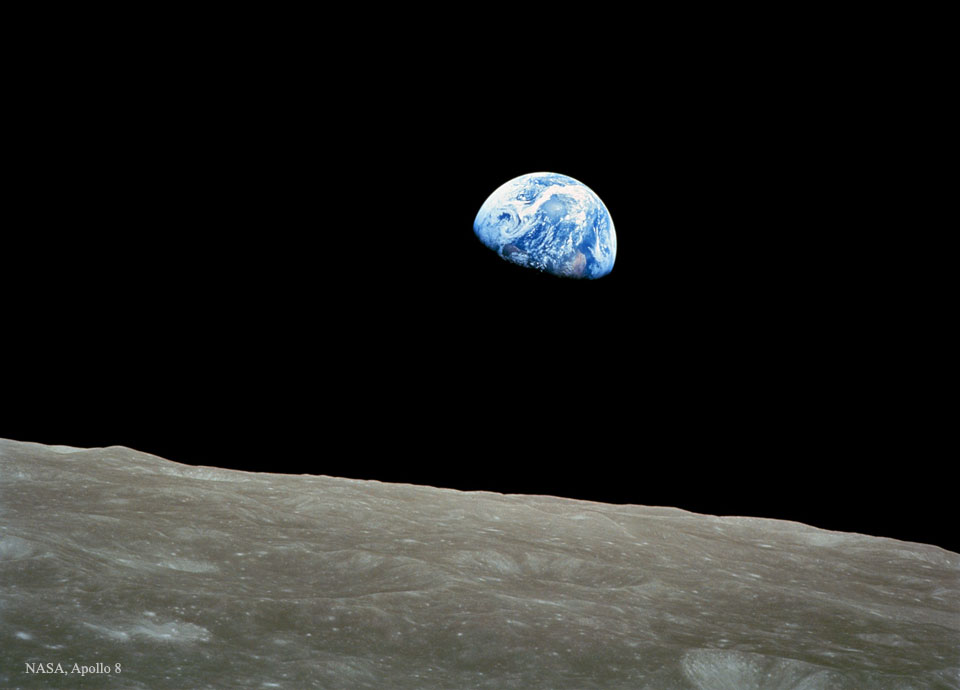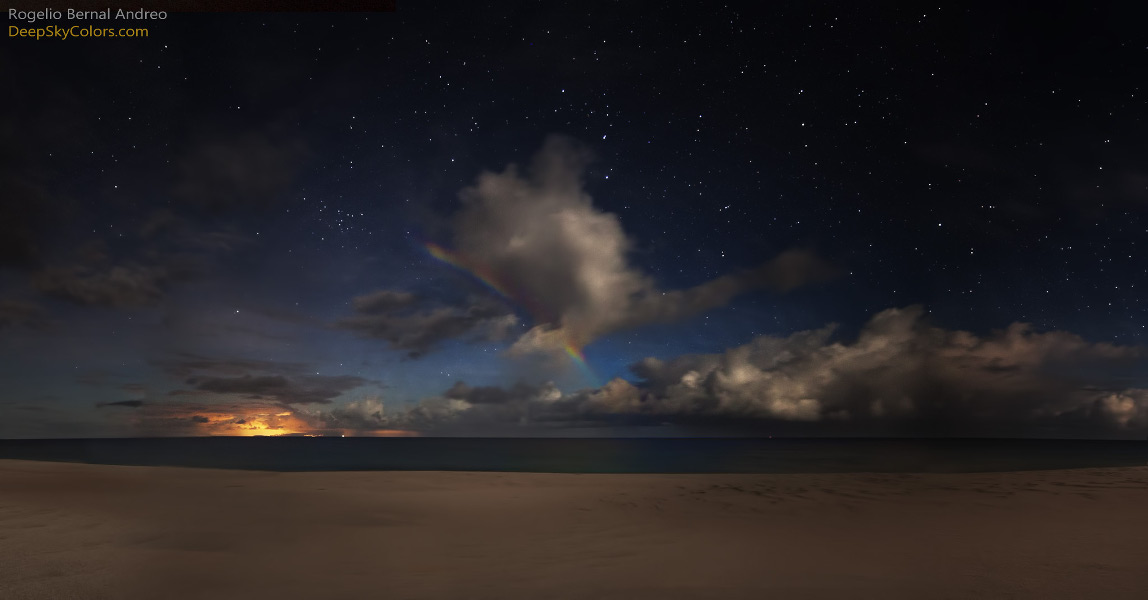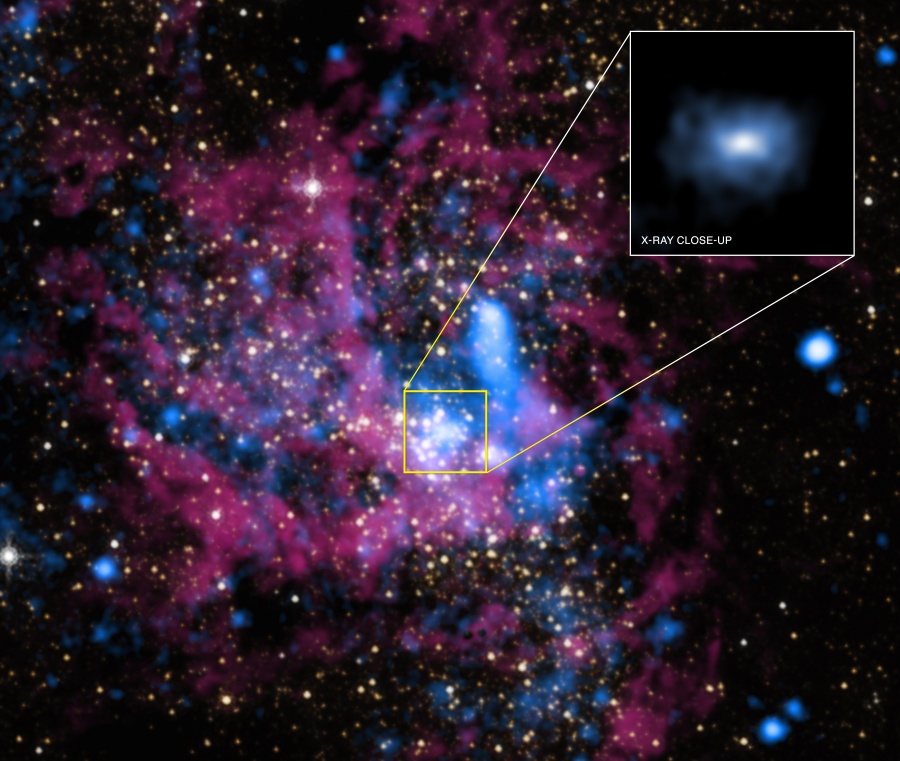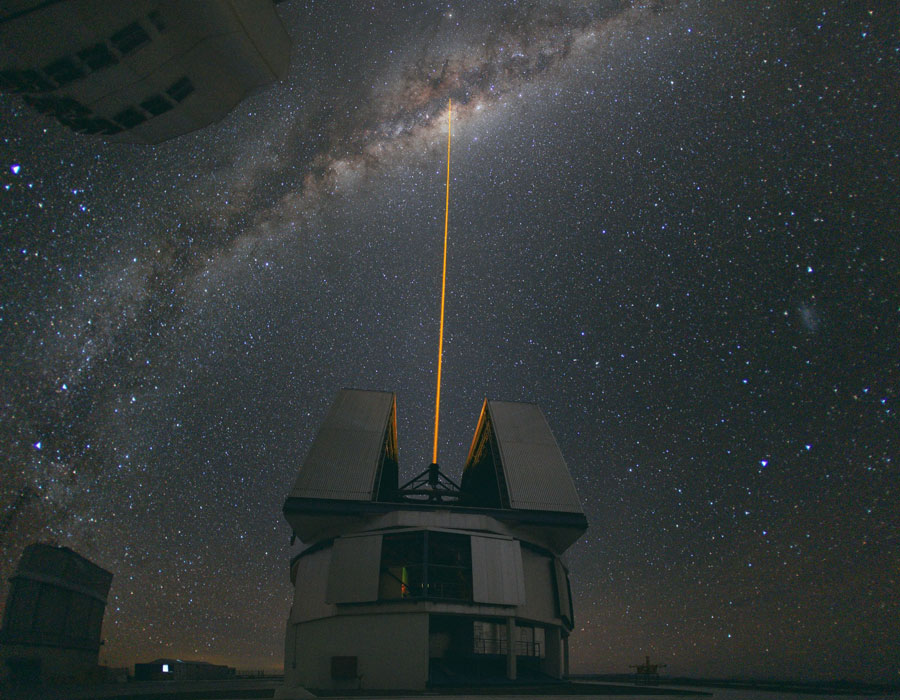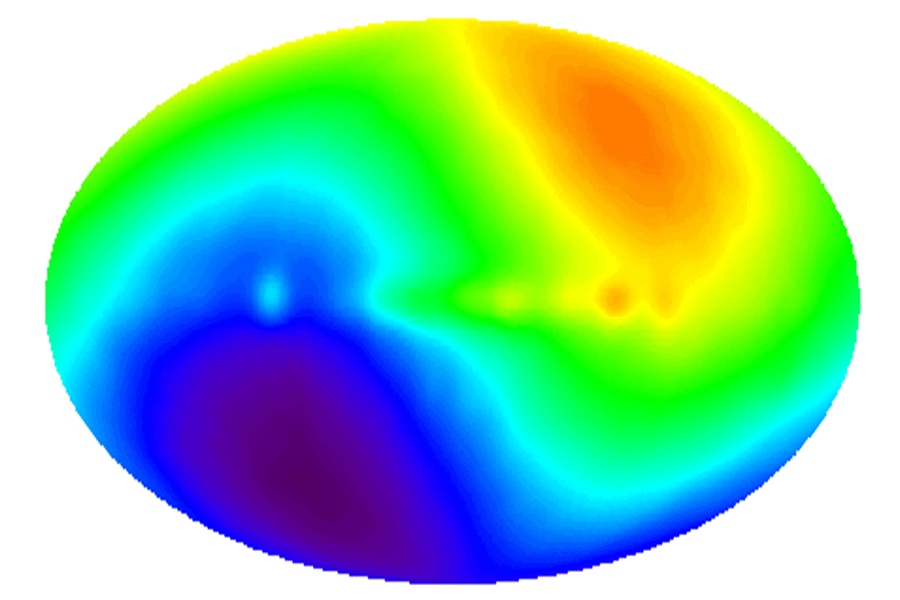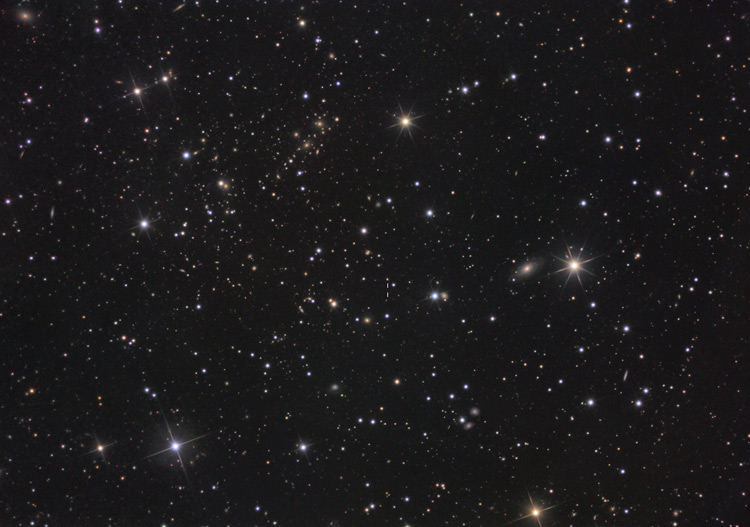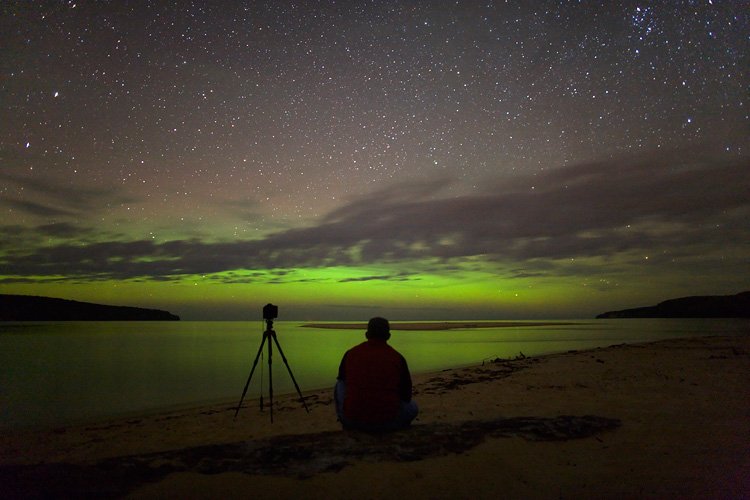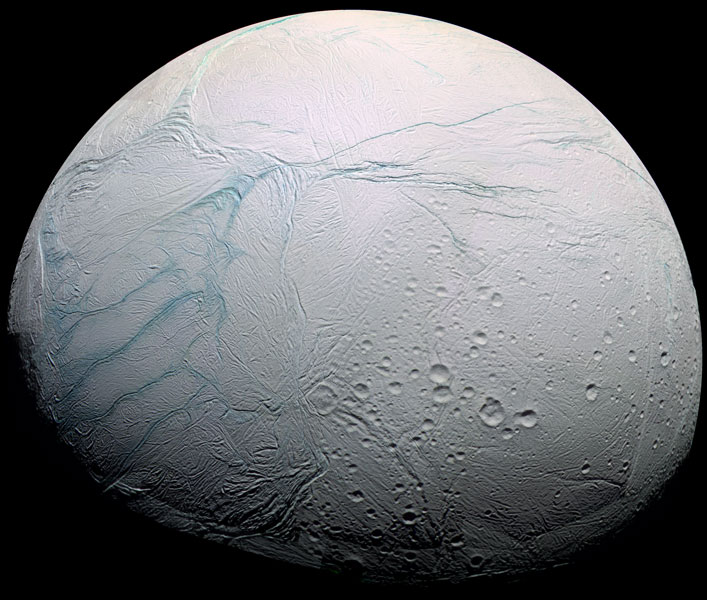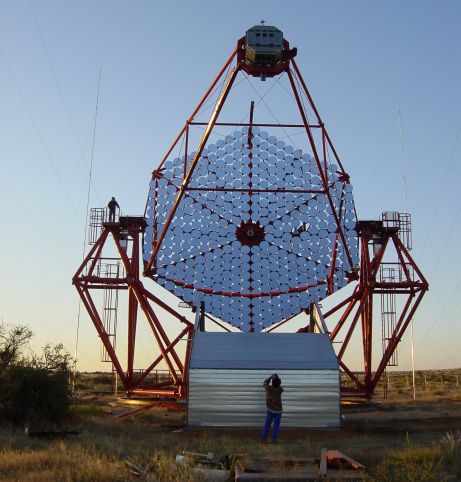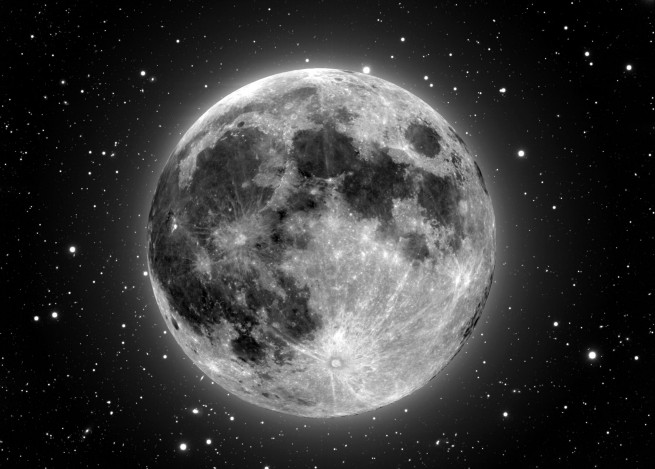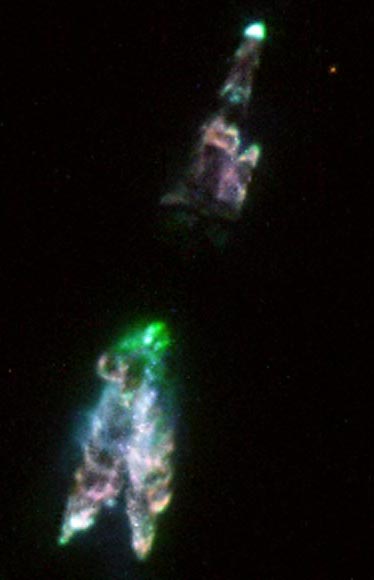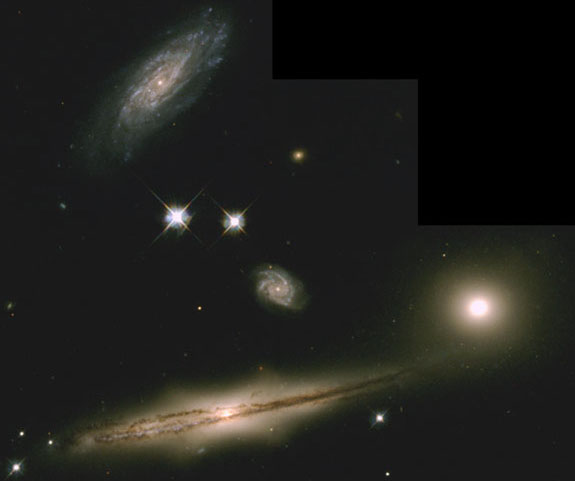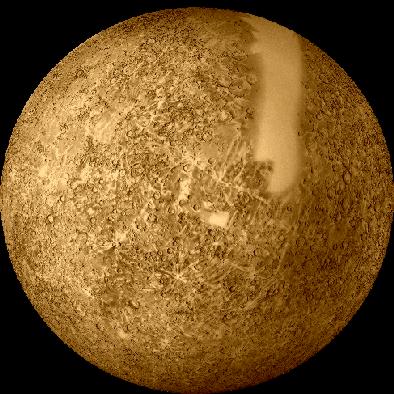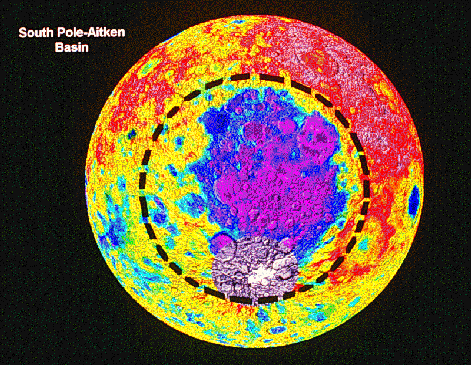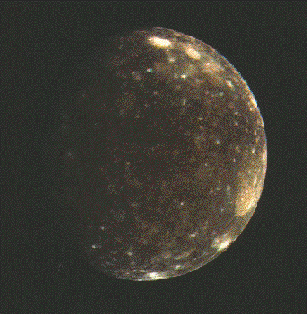| << Previous | Index | Next >> |
2015 What's that rising over the edge of the Moon? Earth. About 47 years ago, in December of 1968, the Apollo 8 crew flew from the Earth to the Moon and back again. Frank Borman, James Lovell, and William Anders were launched atop a Saturn V rocket on December 21, circled the Moon ten times in their command module, and returned to Earth on December 27. The Apollo 8 mission's impressive list of firsts includes: the first humans to journey to the Earth's Moon, the first to fly using the Saturn V rocket, and the first to photograph the Earth from deep space. As the Apollo 8 command module rounded the farside of the Moon, the crew could look toward the lunar horizon and see the Earth appear to rise, due to their spacecraft's orbital motion. Their famous picture of a distant blue Earth above the Moon's limb was a marvelous gift to the world.
2014 Like a rainbow at night, a beautiful moonbow shines above the western horizon in this deserted beach scene from Molokai Island, Hawaii, USA, planet Earth. Captured last June 17 in early morning hours, the lights along the horizon are from Honolulu and cities on the island of Oahu some 30 miles away. So where was the Moon? A rainbow is produced by sunlight internally reflected in rain drops from the direction opposite the Sun back toward the observer. As the light passes from air to water and back to air again, longer wavelengths are refracted (bent) less than shorter ones resulting in the separation of colors. And so the moonbow is produced as raindrops reflect moonlight from the direction opposite the Moon. That puts the Moon directly behind the photographer, still low and rising over the eastern horizon, a few days past its full phase.
2013 Hot gas is hard to swallow. At least that seems to be true for the supermassive black hole at the center of our Milky Way Galaxy. Known as source Sagittarius A*, the Milky Way's black hole is centered in this infrared (red and yellow hues) and X-ray (blue) composite. Based on data from an extensive campaign of observations by the orbiting Chandra X-ray telescope, the diffuse emission surrounding the black hole is seen in the close-up inset, the inset field spanning about 1/2 light-year across the galactic center some 26,000 light-years away. Astronomers have found that the X-ray emission originates in hot gas drawn from the winds of massive young stars in the region. The Chandra data indicate that only about 1% or less of the gas within the black hole's gravitational influence ever reaches the event horizon, losing enough heat and angular momentum to fall into the black hole, while the rest of the gas escapes in an outflow. The result explains why the Milky Way's black hole is so quiet, much fainter than might be expected in energetic X-rays. It likely holds for most supermassive black holes in galaxies in the nearby Universe.
2012 In this serene night skyscape, the Milky Way's graceful arc stretches over prominent peaks in the Italian Alps known as Tre Cime di Lavaredo. A 180 degree wide-angle panorama made in four exposures on August 24, the scene does look to the north and the sky is suffused with an eerie greenish light. Still, the subtle glowing bands are not aurorae, but airglow. Unlike aurorae powered by collisions with energetic charged particles and seen at high latitudes, airglow is due to chemiluminescence, the production of light in a chemical reaction, and found around the globe. The chemical energy is provided by the Sun's extreme ultraviolet radiation. Like aurorae, the greenish hue of this airglow does originate at altitudes of 100 kilometers or so dominated by emission from excited oxygen atoms. More easily seen near the horizon, airglow keeps the night sky from ever being completely dark.
2011 To some, the outline of the open cluster of stars M6 resembles a butterfly. M6, also known as NGC 6405, spans about 20 light-years and lies about 2,000 light years distant. M6 can best be seen in a dark sky with binoculars towards the constellation of Scorpius, coving about as much of the sky as the full moon. Like other open clusters, M6 is composed predominantly of young blue stars, although the brightest star is nearly orange. M6 is estimated to be about 100 million years old. Determining the distance to clusters like M6 helps astronomers calibrate the distance scale of the universe.
2010 Why are these people shooting a powerful laser into the center of our Galaxy? Fortunately, this is not meant to be the first step in a Galactic war. Rather, astronomers at the Very Large Telescope (VLT) site in Chile are trying to measure the distortions of Earth's ever changing atmosphere. Constant imaging of high-altitude atoms excited by the laser -- which appear like an artificial star -- allow astronomers to instantly measure atmospheric blurring. This information is fed back to a VLT telescope mirror which is then slightly deformed to minimize this blurring. In this case, a VLT was observing our Galaxy's center, and so Earth's atmospheric blurring in that direction was needed. As for inter-galaxy warfare, when viewed from our Galaxy's center, no casualties are expected. In fact, the light from this powerful laser would combine with light from our Sun to together appear only as bright as a faint and distant star.
2009 Our Earth is not at rest. The Earth moves around the Sun. The Sun orbits the center of the Milky Way Galaxy. The Milky Way Galaxy orbits in the Local Group of Galaxies. The Local Group falls toward the Virgo Cluster of Galaxies. But these speeds are less than the speed that all of these objects together move relative to the cosmic microwave background radiation (CMBR). In the above all-sky map from the COBE satellite, radiation in the Earth's direction of motion appears blueshifted and hence hotter, while radiation on the opposite side of the sky is redshifted and colder. The map indicates that the Local Group moves at about 600 kilometers per second relative to this primordial radiation. This high speed was initially unexpected and its magnitude is still unexplained. Why are we moving so fast? What is out there?
2008 Only a few stars can be found within ten light-years of our lonely Sun, situated near an outer spiral arm of the Milky Way galaxy. But if the Sun were found within one of our galaxy's star clusters, thousands of stars might occupy a similar space. What would the night sky look like in such a densely packed stellar neighborhood? When Roger Hopkins took this picture at the Montezuma National Wildlife Refuge in the Finger Lakes region of western New York, USA, he was struck by this same notion. Appropriately, he had photographed a flock of starlings against the backdrop of a serene sunset. He then manipulated the image so that the black bird silhouettes were changed to white. The final picture dramatically suggests the tantalizing spectacle of approaching night in crowded skies above a cluster star world.
2007
2006 What if your horizon was green? If you've got a camera, take a picture! That was the experience of Jeff Hapeman last week when visiting the Pictured Rocks National Lakeshore in Michigan. On a quiet night toward the northern horizon over Lake Superior was a long lasting diffuse green aurora. The above image was taken in an effort to capture the sense of wonder one gets when watching an auroral display. Auroras are sparked by energetic particles from the Sun impacting the magnetic environment around the Earth. Resultant energetic particles such as electrons and protons rain down near the Earth's poles and impact the air. The impacted air molecules temporarily lose electrons, and when oxygen molecules among them reacquire these electrons, they emit green light. Auroras are known to have many shapes and colors.
2005 The tiger stripes on Saturn's moon Enceladus might be active. Even today, they may be spewing ice from the moon's icy interior into space, creating a cloud of fine ice particles over the moon's South Pole and creating Saturn's mysterious E-ring. Recent evidence for this has come from the robot Cassini spacecraft now orbiting Saturn. Cassini detected a marked increase in particle collisions during its July flyby only 270 kilometers over a South Polar region of Enceladus. Pictured above, a high resolution image of Enceladus is shown from the close flyby. The unusual surface features dubbed tiger stripes are visible on the left in false-color blue. Why Enceladus is active remains a mystery, as the neighboring moon Mimas, approximately the same size, appears quite dead.
2004 A comet-like tail of glowing gas, 200,000 light-years long, streams from galaxy C153 as it plunges through galaxy cluster Abell 2125 at nearly 8 million kilometers per hour. Itself a member of the giant cluster of galaxies, C153 may once have been a spiral galaxy like the Milky Way. But this remarkable series of images, false-color composites of x-ray and optical data, zooms in on the galaxy's fate. A headlong passage through the hot intracluster gas in the central regions of Abell 2125 is seen to be stripping C153 of its own star forming material and distorting its shape. As other galaxies in the cluster suffer a similar fate, the hot gas collecting in the cluster's core should become enriched in heavy elements. The violent spectacle was taking place about 3 billion light-years from Earth and is thought to illustrate a common process in the cosmic evolution of large clusters of galaxies.
2003 Slice Jupiter from pole to pole, peel back its outer layers of clouds, stretch them onto a flat surface ... and for all your trouble you'd end up with something that looks a lot like this. Scrolling right will reveal the full picture, a color mosaic of Jupiter from the Cassini spacecraft. The mosaic is actually a single frame from a fourteen frame movie constructed from image data recorded by Cassini during its leisurely flyby of the solar system's largest planet in late 2000. The engaging movie approximates Jupiter's cloud motions over 24 jovian rotations. To make it, a series of observations covering Jupiter's complete circumference 60 degrees north and south of the equator were combined in an animated cylindrical projection map of the planet. As in the familiar rectangular-shaped wall maps of the Earth's surface, the relative sizes and shapes of features are correct near the equator but become progressively more distorted approaching the polar regions. In the Cassini movie, which also features guest appearances by moons Io and Europa, the smallest cloud structures visible at the equator are about 600 kilometers across.
2002 Most ground-based telescopes with lenses and mirrors are hindered by the Earth's nurturing, protective atmosphere that blurs images and scatters and absorbs light. But this telescope was designed to detect extreme gamma rays - photons with over 100 billion times the energy of visible light - and actually requires the atmosphere to operate. As the gamma rays impact the upper atmosphere they produce air showers of high-energy particles. Adorned with 382 separate mirrors each 60 centimeters in diameter and equipped with a fast camera, the telescope records in detail the brief flashes of optical light, called Cherenkov light, created by the air shower particles. The telescope pictured here was inaugurated this week and is intended to operate as part of the High Energy Stereoscopic System (HESS) array under construction in Namibia. The initial phase of HESS will consist of four telescopes working in concert to provide multiple stereoscopic views of the air showers, relating them to the energies and directions of the incoming cosmic gamma rays.
2001 Here's something you don't see too often ... a detailed picture of the full Moon surrounded by a rich field of background stars. It's true that bright moonlight scattered by the atmosphere tends to mask faint stars, but pictures of the sunlit portion of the Moon made with earthbound telescopes or even with cameras on the lunar surface often fail to show any background stars at all. Why? Because the exposure times are too short. Very short exposures, lasting fractions of a second, are required to accurately record an image of the bright lunar surface. But the background stars (and galaxies!) such as those visible above are much fainter and need exposures lasting minutes to hours which would seriously overexpose the surface of the Moon. So, of course this stunning view really is a combination of two digital images -- a short exposure, registering the exquisite lunar surface details at full Moon, superposed on a separate very long exposure, made with the Moon absent from the star field. The final representation of Moon and background stars is very dramatic, even though it could not have been captured in a single exposure.
2000 CRL 618 may look to some like an Olympian declaring victory. Only a few hundred years ago, however, CRL 618 appeared as a relatively modest red giant star. Since then it has run out of core material to fuse and so has started to become a planetary nebula. In its current proto-planetary nebula phase, CRL 618 is evolving quickly, expelling hot gasses in complex jets and rings moving outwards faster than 700,000 kilometers per hour. In a few thousand years, the glowing core of the cool red giant will be bare, revealing a hot white dwarf star. Much remains unknown about planetary nebulae formation, including details of how geometries like this form. Perhaps one day some part of this nebula will be able to declare victory - CRL 618 has an extraordinary abundance of carbon-chain molecules.
1999
1998 Mercury, the closest planet to the Sun, remains the most mysterious of the Solar System's inner planets. Hiding in the Sun's glare it is a difficult target for Earth bound observers. The only spacecraft to explore Mercury close-up was Mariner 10 which executed 3 flybys of Mercury in 1974 and 1975, surveying approximately 45 percent of its surface. Mariner 10 deftly manuevered to photograph part of the sunlit hemisphere during each approach, passed behind the planet, and continued to image the sun-facing side as the spacecraft receded. Its highest resolution photographs recorded features approximately a mile across. A recent reprocessing of the Mariner 10 data has resulted in this dramatic mosaic. Like the Earth's Moon, Mercury's surface shows the scars of impact cratering - the smooth vertical band and patches visible above represent regions where no image information is available.
1997 Sir Isaac Newton changed the world. Born in 1643, Newton was only an above-average student. But he went home from Cambridge one summer in 1665, thought a lot about the physical nature of the world, and came back two years later with a revolutionary understanding of mathematics, gravitation, and optics. A Professor of his, upon understanding what Newton had done, resigned his own position at Cambridge so Newton could have it. Newton's calculus provided a new mathematical framework for the rapid solution of whole classes of physical problems. Newton's law of gravitation explained in one simple formula how apples fall and planets move. Newton's insights proved to be so overwhelmingly powerful he was the first scientist ever knighted.
1996 What is the largest known impact crater in the Solar System? Over 1300 miles across, the South Pole-Aitken Basin on the farside of Earth's Moon holds that distinction. Circled above in a false color mosaic of Clementine images it was caused when an asteroid or comet sized object crashed into the surface, penetrating the lunar mantle. In general, the rocky terrestrial planets and moons are scarred and battered from frequent repeated bombardment by large objects during our Solar System's early years. On Earth, continuous geological activity has hidden much of the damage, but the surface of the smaller, less active Moon bears testimony to a shared history of fierce and frequent impacts. At the present time in the vicinity of Earth, the bombardment continues - fortunately at a greatly reduced rate.
1995 Callisto is a dirty battered world, showing the most beaten surface of Jupiter's major moons. Made of a rocky core covered by fractured ice, Callisto's past collisions with large meteors are evident as large craters surrounded by concentric rings. The four largest moons of Jupiter: Io, Europa, Ganymede, and Callisto were all discovered by Galileo and Marius in 1610 with early telescopes and are now known as the Galilean satellites. The NASA spacecraft Galileo is scheduled to arrive at Jupiter is December of 1995.
| << Previous | Index | Next >> |
